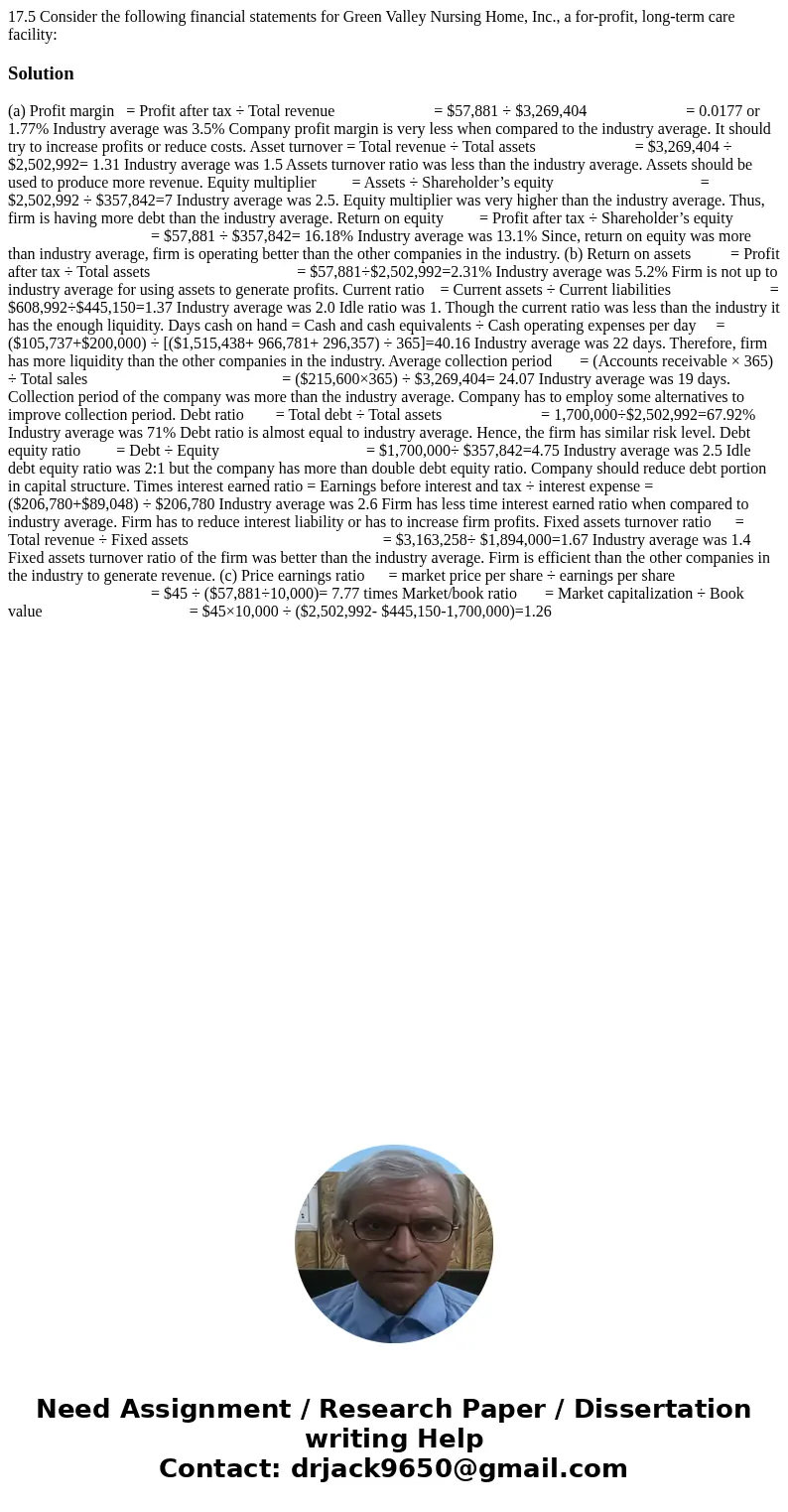175 Consider the following financial statements for Green Va
17.5 Consider the following financial statements for Green Valley Nursing Home, Inc., a for-profit, long-term care facility: 
Solution
(a) Profit margin = Profit after tax ÷ Total revenue = $57,881 ÷ $3,269,404 = 0.0177 or 1.77% Industry average was 3.5% Company profit margin is very less when compared to the industry average. It should try to increase profits or reduce costs. Asset turnover = Total revenue ÷ Total assets = $3,269,404 ÷ $2,502,992= 1.31 Industry average was 1.5 Assets turnover ratio was less than the industry average. Assets should be used to produce more revenue. Equity multiplier = Assets ÷ Shareholder’s equity = $2,502,992 ÷ $357,842=7 Industry average was 2.5. Equity multiplier was very higher than the industry average. Thus, firm is having more debt than the industry average. Return on equity = Profit after tax ÷ Shareholder’s equity = $57,881 ÷ $357,842= 16.18% Industry average was 13.1% Since, return on equity was more than industry average, firm is operating better than the other companies in the industry. (b) Return on assets = Profit after tax ÷ Total assets = $57,881÷$2,502,992=2.31% Industry average was 5.2% Firm is not up to industry average for using assets to generate profits. Current ratio = Current assets ÷ Current liabilities = $608,992÷$445,150=1.37 Industry average was 2.0 Idle ratio was 1. Though the current ratio was less than the industry it has the enough liquidity. Days cash on hand = Cash and cash equivalents ÷ Cash operating expenses per day = ($105,737+$200,000) ÷ [($1,515,438+ 966,781+ 296,357) ÷ 365]=40.16 Industry average was 22 days. Therefore, firm has more liquidity than the other companies in the industry. Average collection period = (Accounts receivable × 365) ÷ Total sales = ($215,600×365) ÷ $3,269,404= 24.07 Industry average was 19 days. Collection period of the company was more than the industry average. Company has to employ some alternatives to improve collection period. Debt ratio = Total debt ÷ Total assets = 1,700,000÷$2,502,992=67.92% Industry average was 71% Debt ratio is almost equal to industry average. Hence, the firm has similar risk level. Debt equity ratio = Debt ÷ Equity = $1,700,000÷ $357,842=4.75 Industry average was 2.5 Idle debt equity ratio was 2:1 but the company has more than double debt equity ratio. Company should reduce debt portion in capital structure. Times interest earned ratio = Earnings before interest and tax ÷ interest expense = ($206,780+$89,048) ÷ $206,780 Industry average was 2.6 Firm has less time interest earned ratio when compared to industry average. Firm has to reduce interest liability or has to increase firm profits. Fixed assets turnover ratio = Total revenue ÷ Fixed assets = $3,163,258÷ $1,894,000=1.67 Industry average was 1.4 Fixed assets turnover ratio of the firm was better than the industry average. Firm is efficient than the other companies in the industry to generate revenue. (c) Price earnings ratio = market price per share ÷ earnings per share = $45 ÷ ($57,881÷10,000)= 7.77 times Market/book ratio = Market capitalization ÷ Book value = $45×10,000 ÷ ($2,502,992- $445,150-1,700,000)=1.26
 Homework Sourse
Homework Sourse